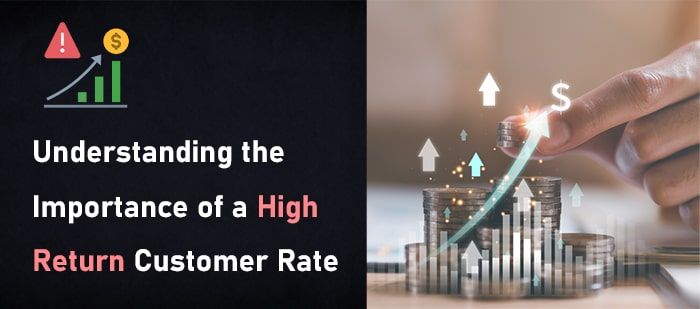
As a business owner, one of your top priorities is undoubtedly to attract new customers. However, have you ever considered the importance of retaining your existing customers? This is where the return customer rate comes into play. Return customer rate refers to the percentage of customers who make a repeat purchase from your business.
This metric is crucial as it reflects the loyalty of your customers and the overall health of your business. In this blog post, we will dive into the significance of a high return customer rate and how it can impact the success of your business. So, let’s understand why keeping your existing customers happy and coming back for more is just as important, if not more, than acquiring new ones.
Defining Return Customer Rate and Why It Matters
The Return Customer Rate (RCR) is a key performance indicator that measures the proportion of customers who return to make additional purchases after their initial buy. This metric is calculated by dividing the number of customers who have made more than one purchase by the total number of unique customers within a specific timeframe, then multiplying the result by 100 to get a percentage.
Understanding your business’s RCR is pivotal as it sheds light on customer loyalty and satisfaction—two vital components for sustainable growth. A high RCR indicates a loyal customer base that believes in the value of your products or services enough to return for more. This not only helps in establishing a stable revenue stream but also in reducing the costs associated with acquiring new customers.
In essence, a high RCR signifies that your business is successfully meeting or exceeding customer expectations, fostering a positive brand image, and creating a loyal customer community. Consequently, focusing on improving your RCR is not just about boosting sales—it’s about building a solid foundation for long-term success and customer relationships.
Some Related Blogs
- Arbitration Chargeback: What You Need to Know
- Dispute Apple Pay Transactions: What You Need to Know
- 5 Proven Strategies for Managing Chargebacks
- Loyalty Fraud: Unmasking the Threat of Chargebacks
The Connection Between Customer Satisfaction and RCR
The link between customer satisfaction and Return Customer Rate (RCR) is undeniable. Satisfied customers are more likely to make repeat purchases, contributing positively to your RCR.
This satisfaction stems from various factors including the quality of your product or service, the level of customer service provided, and the overall experience of shopping with your brand. When customers feel valued and have their expectations met or exceeded, they not only become loyal patrons but also act as brand advocates, further amplifying your customer base through word-of-mouth referrals. Consequently,
monitoring customer feedback and addressing any areas of dissatisfaction promptly can significantly enhance your RCR. By implementing strategies that focus on improving customer satisfaction, you create a virtuous cycle where increased loyalty leads to higher RCR.
Which in turn, fosters a more committed customer base willing to support your business over time. Understanding and nurturing this connection is key to unlocking the full potential of your RCR, making customer satisfaction an essential element in the equation for business success.
Strategies to Boost Your Return Customer Rate
To effectively increase your Return Customer Rate (RCR), implementing targeted strategies is key. First, personalize the customer experience by leveraging data to tailor communication and offers. This can mean personalized emails, recommendations, and even rewards that resonate with their past purchases and preferences.
Next, enhance customer service by ensuring quick response times, helpful assistance, and multiple channels for support, including social media, email, and live chat. Offering loyalty programs can also incentivize repeat business by rewarding customers for their continued patronage with discounts, exclusive offers, or early access to new products.
![]()
Email us anytime!
Email customer service 24/7
![]()
Call us anytime!
Reach customer care 24/7 at +1 (888) 901-8653
Additionally, soliciting and acting on customer feedback demonstrates that you value their input and are committed to improving their experience. Regularly reviewing customer feedback and implementing changes based on their suggestions can significantly enhance customer satisfaction and loyalty.
Finally, ensure your product or service quality consistently meets or exceeds expectations. High-quality offerings are the cornerstone of repeat business, as customers are more likely to return if they are assured of the value they receive. By focusing on these strategies, businesses can create a compelling reason for customers to continue choosing their brand over competitors, thereby boosting their Return Customer Rate.
Measuring the Impact of RCR on Your Business’s Bottom Line
Quantifying the impact of your Return Customer Rate (RCR) on the financial health of your business is a critical step in appreciating its value. A robust RCR translates into more predictable and stable revenue streams. Repeat customers tend to spend more over time, contributing to an increase in the average transaction value.
This is because they have already experienced the value of your products or services and trust your brand. Furthermore, the cost of selling to a returning customer is significantly lower than that of acquiring a new one, thanks to the eliminated or reduced expenditure on marketing and advertising aimed at gaining their initial business.
This decrease in customer acquisition cost directly improves profit margins, allowing for more flexibility and investment in other areas of your business, such as product development or customer service enhancements. Additionally, loyal customers often become brand advocates, indirectly supporting your marketing efforts by spreading positive word-of-mouth and potentially attracting new customers at no additional cost to you.
Therefore, a high RCR not only boosts your bottom line through direct sales but also enhances marketing efficiency and reduces overall operational costs, showcasing its profound influence on your business’s financial health.

